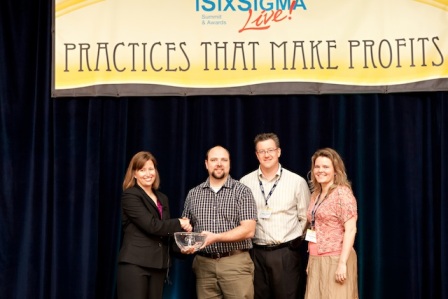
The streets of the French Quarter are no doubt still packed with happy Saints fans following Sunday’s surprising and convincing win against the favored Colts. As first-time champs, it’s a feeling the players and fans will never forget. We at iSixSigma are also enjoying the afterglow of a first-time Bowl event: iSixSigma’s Project Bowl contest, held last week at the Summit & Awardsshow in Miami.
The Project Bowl, held on the first day of the conference, Feb. 1,pitted teams of two or three Summit attendees against each other in a race to see who could complete a DMAIC project simulation the fastest and present a final tollgate at the end of the day. All told, five teams joined the fray–four who had pre-registered for the Project Bowl and one “pick-up” team that joined at the Summit. The cleverly named participants were:
- 2 Guys, a Girl and a Laptop (aka Team Gift Card): From Best Buy
- The Atoms (aka Los Alamost): From Los Alamos National Laboratory
- The Cornbelters: From State Farm
- The DMAIC Detectives: Ilona Kirzhner, an independent consultant, and Scott Stone, with Aptuit
- DMAIC Duo (aka Super Crunchers): Artagnan Ayala, an independent consultant, and Steve Style, with Cargill (pick-up team).
The teams completed a modified SigmaBrew simulation, made possible by the work of three sponsors: CS International, MoreSteam.com and Minitab. A wireless connection was provided for the participants, who were allowed to choose the statistical analysis software of their choice. The official time of the event was from 8 a.m. to5 p.m., with a break for lunch provided. But as the tension mounted and the deadline drew near, four of the teams decided to skip lunch and keep on working.
By 4 p.m. the teams made a presentation to the judges and a winner, the team from Best Buy, was announced on Wed., Feb. 3, during the awards ceremony, where the three team members went home with the first annual Project Bowl trophy. Those who did not walk away with any hardware, however, should also be congratulated for a job well done. One teamsaid it plans to keep working on the simulation and finish it afterthey’re back in the office.

Project Bowl I is now history. But no sooner was the event over when talk began about plans for the next competition. During Monday night’s reception,many participants could be overheard offering suggestionsabout how to make Project Bowl II even better. Stay tuned to the iSixSigma Live! site for more details later in the year.